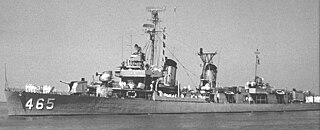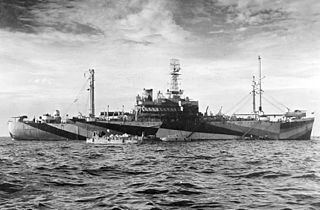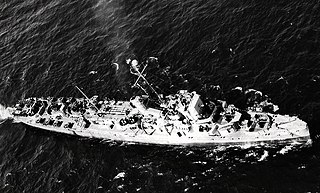
USS Abercrombie (DE-343) was a John C. Butler-class destroyer escort in the service of the United States Navy from 1944 to 1946. She was finally sunk as a target in 1968.

USS Crosby (DD–164) was a Wickes-class destroyer in the United States Navy during World War II, later reclassified as APD-17. She was named for Admiral Peirce Crosby.

USS Saufley (DD/DDE/EDDE-465), a Fletcher-class destroyer, was a warship of the United States Navy named for pioneering Naval Aviator, Lieutenant Richard Saufley, USN.

USS Goldsborough (DD-188/AVP-18/AVD-5/APD-32) was a Clemson-class destroyer in the United States Navy during World War II. She was the second Navy ship named for Rear Admiral Louis M. Goldsborough (1805–1877). Entering service in 1920, the ship had a brief active life before being placed in reserve in 1922. Goldsborough was reactivated for World War II and was used as an aircraft tender, destroyer and high speed transport in both Atlantic and Pacific theaters. Following the war, the ship was sold for scrapping in 1946.

USS Haraden (DD-585), a Fletcher-class destroyer, was the second ship of the United States Navy to be named for Jonathan Haraden (1744–1803), a privateer of the American Revolutionary War.

USS Kane (DD-235/APD-18) was a Clemson-class destroyer in the United States Navy during World War II. She was the first ship named for Elisha Kent Kane.

USS Robinson (DD-562), a Fletcher-class destroyer, was the second ship of the United States Navy to be named for Captain Isaiah Robinson, who served in the Continental Navy.

USS Dufilho (DE-423), was a John C. Butler-class destroyer escort.

USS Smith (DD-378) was a Mahan-class destroyer in the United States Navy before and during World War II. She was named for Lieutenant Joseph B. Smith, USN. Smith was a senior officer aboard USS Congress and killed when CSS Virginia sank her.

USS Jobb (DE-707) was a Rudderow-class destroyer escort in service with the United States Navy from 1944 to 1946. She was sold for scrap in 1970.

USS Liddle (DE-206/APD-60), a Buckley-class destroyer escort of the United States Navy, in service from 1943 to 1946. She was recommissioned from 1950 to 1959 and from 1961 to 1967, before being sold for scrap.

USS Rocky Mount (AGC-3) was an Appalachian-class command ship in the United States Navy.

USS Hopping (DE-155) was a Buckley-class destroyer escort in service with the United States Navy from 1943 to 1947. In 1944, she was converted to a Charles Lawrence-class high speed transport and redesignated "APD-51". She was sold for scrap in 1966.

USS Newman (DE-205/APD-59) was a Buckley-class destroyer escort in service with the United States Navy from 1943 to 1946. She was scrapped in 1966.

USS Cofer (DE-208/APD-62) was a Buckley-class destroyer escort in service with the United States Navy from 1944 to 1946. She was scrapped in 1968.

USS Lloyd (DE-209/APD-63), a Buckley-class destroyer escort of the United States Navy, was named in honor of Ensign William R. Lloyd (1916–1942).

USS Wasatch (AGC-9) was a Mount McKinley-class amphibious force command ship, named after a mountain chain in northern Utah. She was designed as a cargo ship and converted into an amphibious force flagship, a floating command post with advanced communications equipment and extensive combat information spaces to be used by the amphibious forces commander and landing force commander during large-scale operations.

USS Key (DE-348) was a John C. Butler-class destroyer escort in service with the United States Navy from 1944 to 1946. She was scrapped in 1972.

USS Crosley (APD-87) was a Crosley-class high speed transport that served in the United States Navy from 1944 to 1946.

USS John Q. Roberts (APD-94), ex-DE-235, was a United States Navy high-speed transport in commission from 1945 to 1946.






















